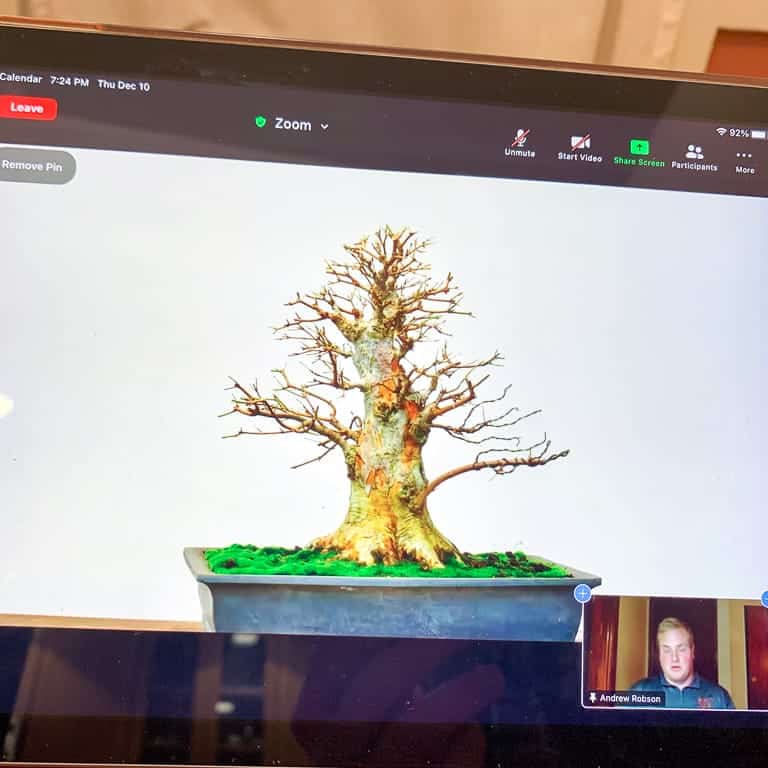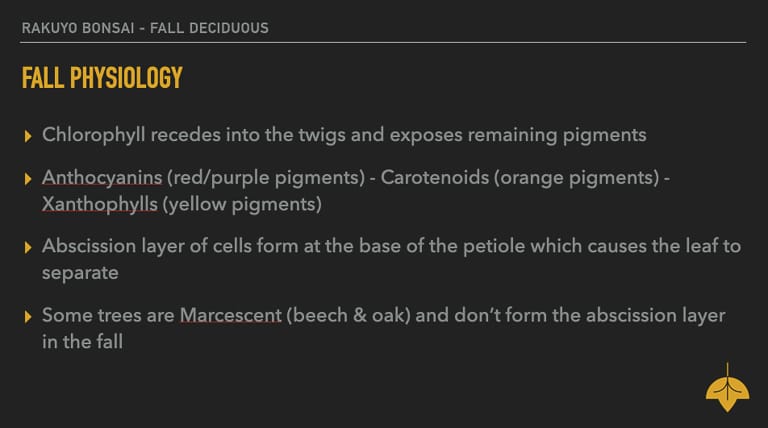Before heading out for a brief winter break (new posts will resume January 5th), I wanted to share some tips on hosting virtual bonsai presentations.
If your club is familiar with the format, you know the good and bad of it. On the plus side, online presentations:
- Give all participants “front row seats” for demonstrations
- Provide opportunities for members to take a more active role in club meetings (more on this below)
- Offer a great way to work with new presenters from other parts of the country – or world
On the minus side, not everyone is comfortable with virtual meetings and technical glitches can get in the way. On the whole, however, online presentations are a great way to share bonsai information and maintain connections among club members.

My bonsai entertainment for the evening
Over the course of the year, I’ve given a lot of virtual presentations and have attended almost as many as an audience member. As an encouragement for you to host presentations for your clubs, I’d like to share some of the formats and techniques that I’ve seen work well.
1. Informational programs. The first virtual presentation I attended this year was by Michael Greenstein of the Kusamura Bonsai Club. The presentation consisted of a slide show outlining horticultural information about oaks followed by photos of different oak species with tips on their culture as bonsai.
This format works well for species or techniques that are relevant to club members. And while these presentations can be great when the speakers have experience with a given topic, they can work just as well when presented by club members with great interest in a topic.
2. Interactive slide shows. Andrew Robson gives great presentations. In a talk about deciduous winter care and styling, Andrew shared slides of deciduous trees at various stages of development and drew directly on the slides to indicate which branches could be cut and which needed to grow.
This was a great example of something that’s easier done on a screen than by waving an arm around a tree to indicate a future silhouette.
3. Time-lapse demonstrations. Tony Tickle presented a in-depth look at how to develop collected hawthorns as part of the East Bay Bonsai Society’s virtual show earlier this year. In the presentation, Tony managed something that isn’t part of a standard demonstration: he showed us the results of his work.
It’s one thing to transform a tree before the audience’s eyes, but it’s another to show what a tree looks like as a result of the work that was done. Tony shared beautiful examples of the process he follows to make world-renown hawthorn bonsai. I highly recommend him as a presenter!
4. Video clip presentations. Bjorn Bjorholm produces outstanding video content. It’s natural, therefore, that he puts this talent to use in his presentations.
By recording detailed footage of specific bonsai techniques, Bjorn can share video content with participants and then follow-up with live Q&A. Close-up shots and careful editing provide crystal clear examples that are easy to learn from.
5. Conversational “show-and-tell” programs. One of the best things about presenting online is that I get to sit down and hang out with bonsai enthusiasts from around the country. I like it best when I can see the participants’ faces and they’re free to interject with questions throughout the presentation.
Some of my favorite presentations have been “show-and-tell” programs in which I show trees or techniques that I’ve learned from over the years. Topics like Ten Things I Wish I Knew when I Started Bonsai, and Long-Term Strategies for Developing Quality Bonsai from Scratch give me the opportunity to share successes and failures in hopes that others can learn from my experience.
6. Member Q&A. A great add-on to any of the above approaches is to solicit questions from club members about their trees. This can be done by asking members to provide photos ahead of time, encouraging them to share their screens live, or simply making time for them to speak up to make sure timely questions are addressed.
The focus can be Q&A or show-and-tell depending on members’ needs. The format is particularly effective when photos are sent in ahead of time to a presenter who can manage the screen sharing. (If you’re unsure about how to take clear pictures of your trees your trees, see “Photographing bonsai” for tips.)
7. Conventional demonstrations. If club members are looking forward to watching someone work on a tree, conventional demonstrations can work well online.
The format is familiar to anyone who has seen the online offerings from Bjorn, Ryan Neil, Bonsai Empire, or Boon Manakitivipart and can be a great complement to the approaches noted above.
If your club is new to online presentations, keeping things simple is a great way to start. Plenty of clubs have experience at this point and many would be happy to provide pointers.

A slide from Andrew’s Deciduous Winter Care presentation
I suspect the above tips are familiar to many of you, and I’m certain I’ve left out a number of great ideas. If you have suggestions for people who are preparing online bonsai presentations, feel free to share them in the comments below.
Satsuki azalea update
I recently updated the satsuki sales page with photos of available trees. Domestic shipping (post the holiday season) is available for some, but not all trees.
You can browse the azaleas at the Satsuki Sales Page. Feel free to write with any questions.
✕
Subscribe to Indian Bonsai Art
New Posts Delivered Every Tuesday and Friday
